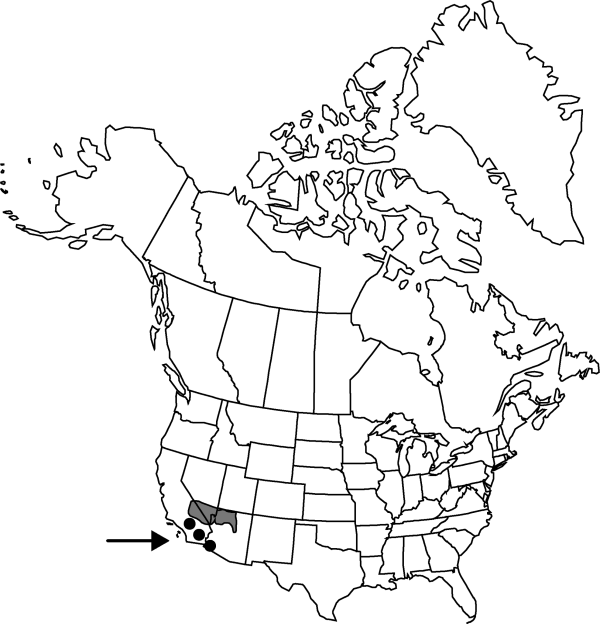Difference between revisions of "Echinocactus polycephalus"
Proc. Amer. Acad. Arts 3: 276. 1856.
FNA>Volume Importer |
RevisionBot (talk | contribs) m (Bot: Adding category Revised Since Print) |
||
| (7 intermediate revisions by 3 users not shown) | |||
| Line 20: | Line 20: | ||
-->{{Treatment/Body | -->{{Treatment/Body | ||
| − | |distribution= | + | |distribution=Ariz.;Calif.;Nev.;Mexico. |
|discussion=<p>Varieties 2 (2 in the flora).</p><!-- | |discussion=<p>Varieties 2 (2 in the flora).</p><!-- | ||
--><p>The varieties of <i>Echinocactus polycephalus</i> are distinguishable by several morphologic characteristics. Plants morphologically intermediate between the two varieties, however, occur at one site south of Lake Mead, Arizona, where the geographic ranges of the varieties are contiguous, but ecologically segregated.</p><!-- | --><p>The varieties of <i>Echinocactus polycephalus</i> are distinguishable by several morphologic characteristics. Plants morphologically intermediate between the two varieties, however, occur at one site south of Lake Mead, Arizona, where the geographic ranges of the varieties are contiguous, but ecologically segregated.</p><!-- | ||
| Line 49: | Line 49: | ||
-->{{#Taxon: | -->{{#Taxon: | ||
name=Echinocactus polycephalus | name=Echinocactus polycephalus | ||
| − | |||
|authority=Engelmann & J. M. Bigelow | |authority=Engelmann & J. M. Bigelow | ||
|rank=species | |rank=species | ||
| Line 56: | Line 55: | ||
|basionyms= | |basionyms= | ||
|family=Cactaceae | |family=Cactaceae | ||
| − | |distribution= | + | |distribution=Ariz.;Calif.;Nev.;Mexico. |
|reference=chamberland1997a | |reference=chamberland1997a | ||
|publication title=Proc. Amer. Acad. Arts | |publication title=Proc. Amer. Acad. Arts | ||
|publication year=1856 | |publication year=1856 | ||
|special status= | |special status= | ||
| − | |source xml=https:// | + | |source xml=https://bitbucket.org/aafc-mbb/fna-data-curation/src/2e0870ddd59836b60bcf96646a41e87ea5a5943a/coarse_grained_fna_xml/V4/V4_355.xml |
|subfamily=Cactaceae subfam. Cactoideae | |subfamily=Cactaceae subfam. Cactoideae | ||
|genus=Echinocactus | |genus=Echinocactus | ||
| Line 67: | Line 66: | ||
}}<!-- | }}<!-- | ||
| − | -->[[Category:Treatment]][[Category:Echinocactus]] | + | --> |
| + | |||
| + | [[Category:Treatment]] | ||
| + | [[Category:Echinocactus]] | ||
| + | [[Category:Revised Since Print]] | ||
Latest revision as of 17:01, 6 November 2020
Plants branched from base (rarely unbranched) forming compact mounds of 2–50(–130) branches. Stems gray-green to yellow-green, spheric to short cylindric, 15–40 × (9–)15–30 cm; ribs 11–25, usually vertical, or somewhat helically curving around stem, rib crests not constricted between areoles (slightly so when desiccated), sharp, with flat sides. Spines 10–19 per areole, straight to curved but not hooked, often twisted, red to straw colored, aging gray, flattened to abaxially ridged, annulate-ridged, nearly obscuring stem surfaces, glabrous to canescent with minute, white, unicellular trichomes often obscuring underlying spine color; radial spines 6–14 per areole; central spines 4, abaxial frequently longest, straight to somewhat recurved. Flowers 5.5–5.8 × 4–6 cm, narrower when spines restrict flower from opening fully; inner tepals bright yellow, color uniform from base to apex, 24–26 mm, sparsely, minutely toothed; stigma lobes bright yellow. Fruits dehiscent through basal abscission pore, ovoid, surfaces largely hidden by hairs in axils of scales and long areolar trichomes of stem apex, usually drying to tan shell before seed dispersal, 15–40 mm; scales abundant, yellow to reddish throughout, or yellow with reddish midstripes, flat, tips spinelike, glabrous or canescent. Seeds dark maroon to black, ± obovoid-reniform or comma-shaped, 2.4–4.7 mm, smooth and shiny or granular and dull from protruding surfaces of testa cells; testa cell surfaces sometimes hemispheric to hexagonally faceted.
Distribution

Ariz., Calif., Nev., Mexico.
Discussion
Varieties 2 (2 in the flora).
The varieties of Echinocactus polycephalus are distinguishable by several morphologic characteristics. Plants morphologically intermediate between the two varieties, however, occur at one site south of Lake Mead, Arizona, where the geographic ranges of the varieties are contiguous, but ecologically segregated.
Although Echinocactus polycephalus var. polycephalus and var. xeranthemoides have been reported for southern Utah (L. D. Benson 1982; D. J. Ferguson 1992; G. Unger 1992), M. Chamberland (1995, 1997) found neither populations nor herbarium specimens from the past 100 years.
Selected References
Lower Taxa
Key
| 1 | Scales of fruit 10-14 mm, reddish to maroon, aging tan to black, not protruding beyond dried perianth parts on fruit; seed papillate-roughened (exposed surfaces of testa cells protruding, hemispheric to hexagonally faceted, appearing dull except for the microscopically sparkling individual facets) | Echinocactus polycephalus var. polycepha |
| 1 | Scales of fruit 16-30 mm, reddish, tan, or yellow, aging yellow, usually protruding beyond dried perianth parts on fruit; seed smooth (exposed surfaces of testa cells flat or slightly convex, surfaces uniformly shiny) | Echinocactus polycephalus var. xeranthem |